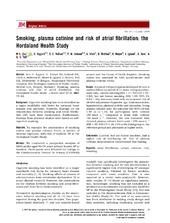| dc.contributor.author | Zuo, Hui | en_US |
| dc.contributor.author | Nygård, Ottar | en_US |
| dc.contributor.author | Vollset, Stein Emil | en_US |
| dc.contributor.author | Ueland, Per Magne | en_US |
| dc.contributor.author | Ulvik, Arve | en_US |
| dc.contributor.author | Midttun, Øivind | en_US |
| dc.contributor.author | Meyer, Klaus | en_US |
| dc.contributor.author | Igland, Jannicke | en_US |
| dc.contributor.author | Sulo, Gerhard | en_US |
| dc.contributor.author | Tell, Grethe S. | en_US |
| dc.date.accessioned | 2018-04-09T11:30:44Z | |
| dc.date.available | 2018-04-09T11:30:44Z | |
| dc.date.issued | 2018-01 | |
| dc.Published | Zuo H, Nygård O, Vollset SE, Ueland PM, Ulvik A, Midttun Ø, Meyer K, Igland J, Sulo G, Tell GST. Smoking, plasma cotinine and risk of atrial fibrillation: the Hordaland Health Study. Journal of Internal Medicine. 2018;283(1):73-82 | eng |
| dc.identifier.issn | 0954-6820 | |
| dc.identifier.issn | 1365-2796 | |
| dc.identifier.uri | https://hdl.handle.net/1956/17582 | |
| dc.description.abstract | Background: Cigarette smoking has been identified as a major modifiable risk factor for coronary heart disease and mortality. However, findings on the relationship between smoking and atrial fibrillation (AF) have been inconsistent. Furthermore, findings from previous studies were based on self‐reported smoking. Objective: To examine the associations of smoking status and plasma cotinine levels, a marker of nicotine exposure, with risk of incident AF in the Hordaland Health Study. Methods: We conducted a prospective analysis of 6682 adults aged 46‐74 years without known AF at baseline. Participants were followed via linkage to the Cardiovascular Disease in Norway (CVDNOR) project and the Cause of Death Registry. Smoking status was assessed by both questionnaire and plasma cotinine levels. Results: A total of 538 participants developed AF over a median follow‐up period of 11 years. Using questionnaire data, current smoking (HR: 1.41, 95% CI: 1.09–1.83), but not former smoking (HR: 1.03, 95% CI: 0.83–1.28), was associated with an increased risk of AF after adjustment for gender, age, body mass index, hypertension, physical activity and education. Using plasma cotinine only, the adjusted HR (95% CI) was 1.40 (1.12–1.75) for participants with cotinine ≥85 nmol L−1 compared to those with cotinine <85 nmol L−1. However, the risk increased with elevated plasma cotinine levels until 1199 nmol L−1 (HR: 1.55, 95% CI: 1.16–2.05 at the third group vs. the reference group) and plateaued at higher levels. Conclusions: Current, but not former smokers, had a higher risk of developing AF. Use of plasma cotinine measurement corroborated this finding. | en_US |
| dc.language.iso | eng | eng |
| dc.publisher | Wiley | eng |
| dc.relation.uri | http://onlinelibrary.wiley.com/doi/10.1111/joim.12689/epdf | |
| dc.rights | Attribution CC BY-NC | eng |
| dc.rights.uri | http://creativecommons.org/licenses/by-nc/4.0/ | eng |
| dc.subject | atrial fibrillation | eng |
| dc.subject | cohort | eng |
| dc.subject | cotinine | eng |
| dc.subject | risk | eng |
| dc.subject | Smoking | eng |
| dc.title | Smoking, plasma cotinine and risk of atrial fibrillation: the Hordaland Health Study | en_US |
| dc.type | Peer reviewed | |
| dc.type | Journal article | |
| dc.date.updated | 2018-01-22T14:32:07Z | |
| dc.description.version | publishedVersion | en_US |
| dc.rights.holder | Copyright 2017 The Author(s) | |
| dc.identifier.doi | https://doi.org/10.1111/joim.12689 | |
| dc.identifier.cristin | 1502076 | |
| dc.source.journal | Journal of Internal Medicine | |

